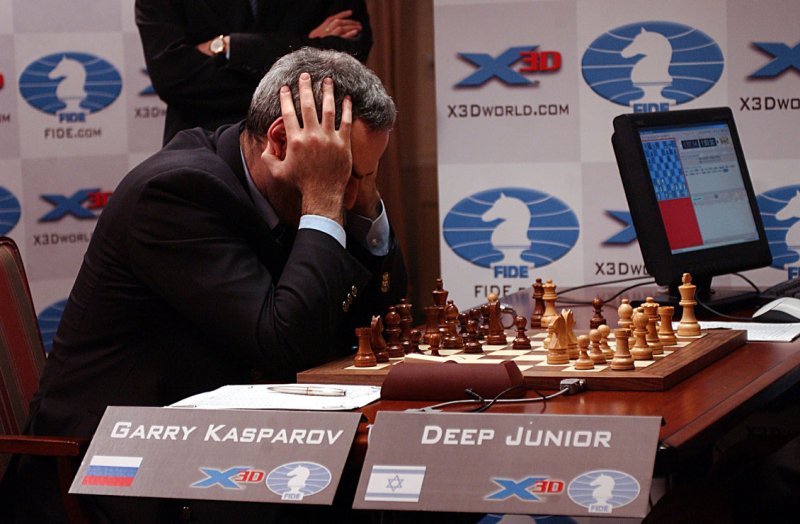Chess Grand Master Garry Kasparov studies the board against the chess supercomputer Deep Junior during their sixth and final match on Feb. 7, 2003 in New York City. Kasparov and the Deep Junior computer concluded their match in a tie. rlw/ep/Ezio Petersen UPI |
License Photo
The human brain is still several years ahead of the supercomputer that now does quadrillions of operations per second (1 quadrillion has 15 zeros). But the gap is closing fast. In fact, Ray Kurzweil, who wrote "The Singularity is Near" eight years ago, predicted parity would be reached 25 to 30 years hence.
Skeptical at first, neuroscientist Jim Olds, who directs the Krasnow Institute at George Mason U, and supervises the Blue Brain Project now believes Kurzweil won't be far off his prediction.
"Real brains are so impressive to computer scientists," says Dr. Olds, "so instead of banging our heads against Moore's Law, why not build computers more like the brain and get them to solve problems the way the brain does?"
"Roadrunner," the IBM supercomputer that experts say "comes closest to replicating a human's ability to drive in rush-hour traffic, "weighs 227 metric tons and requires a diet of about 3 megawatts." By contrast, they explain, the brain regularly handles rush-hour driving on 20 watts -- same power consumption as a Nintendo -- and its 4.5 kilos fit into a handbag.
IBM's research work has the scientific community agog. Its research shows that a model of the human brain with its 20 billion neurons connected by about 200 billion synapses could be reached by 2019.
A critical problem to understand, let alone simulate, the brain is power consumption. Dawn, says one expert, is "one of the most powerful and power-efficient supercomputers in the world, but it still takes 500 seconds for it to simulate 5 seconds of human brain activity, and its consumes 1.4 MW..."
To scale simulation would require "a dedicated nuclear power plant," say the experts.
Nanomaterials -- brain-like chips -- are also being developed by IBM. These are designed to build "a system of 100 such chips stimulating 100 million neurons and 1 trillion synapses."
China, reports the Wall Street Journal, is spending untold millions "on a highly classified system driven by microcircuits that evolve, learn and adapt to real-world situations." And in the U.S., the National Science Foundation is funding a three-year study at the University of Southern California's electrical engineering department "to develop a synthetic cortex, which will contain carbon-based (as opposed to silicon) nanometer-scale artificial neurons."
"Error correction moves propelled quantum computing closer to reality," says privately an aide to a senior U.S. official.
The connectome is the wiring diagram of the brain. And the connection from one brain cell to another is stamped with each person's ID.
Dr. H. Sebastian Seung is known as the connectome's prophet. The wiring of one brain cell to another is seen through an electron microscope. These add up to 85 billion brain cells with 10,000 connections for each brain cell. The whole connectome amounts to one zettabyte, or about one trillion gigabytes, a new designation for the huge amount of data collected.
The ultimate map of the brain on that scale, according to Seung, will take another 20 to 30 years. This is roughly the same as Dr. Kurzweil predicted eight years ago.
What provokes and produces schizophrenia still eludes the scientists. But the drumbeat of soon to be major breakthroughs in neuroscience grows louder by the month.
And what produces capitalist greed and avarice, now spinning out of control, won't come a moment too soon.
In the early post-World War II victory days, CEO comp was roughly 40 times factory floor wages. It has kept going up ever since notwithstanding market downturns. All kinds of emoluments kept expanding. One well publicized case during the last recession had one well-heeled Wall Street trader quitting to protest unfair compensation. He thought he was being short-changed with $80 million.
In 2005, with two wars underway in Iraq and Afghanistan, average defense contractor CEO pay of $11.8 million in salary, stock options, bonuses and incentives rose to 431 times what the average worker earned, or $27,460, according to liberal advocacy organizations. But the stats go unchallenged. And the correct figures are not released to the media.
The liberal report looked at 34 of the top 100 defense contractors 2004-2005 -- all publicly traded companies, easy to verify. Average CEO pay rose 200 percent between 2001 and 2004, as compared to seven percent for all CEOs on Fortune 500 list.
The report said British shareholders "must annually approve executive pay, a tradition that has contributed to greater restraint in executive pay than the U.S. has experienced.
"CEOs themselves could take action." the report said, and then singled out for praise "two bosses worthy of membership in an 'Executive Pay Hall of Fame."















